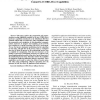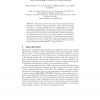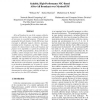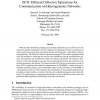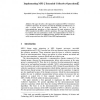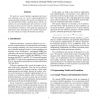103
Voted
IPPS
2010
IEEE
14 years 10 months ago
2010
IEEE
Abstract--This paper explores the computation and communication overlap capabilities enabled by the new CORE-Direct hardware capabilities introduced in the InfiniBand (IB) Host Cha...
102
Voted
PAAPP
2010
14 years 11 months ago
2010
Accurate, reproducible and comparable measurement of the overheads, communication times and progression behavior of blocking and nonblocking collective operations is a complicated...
104
Voted
PC
2007
15 years 9 days ago
2007
This paper presents a case study about the applicability and usage of non blocking collective operations. These operations provide the ability to overlap communication with computa...
109
Voted
IJHPCN
2006
15 years 25 days ago
2006
Abstract-- The performance of collective communication operations is known to have a significant impact on the scalability of some applications. Indeed, the global, synchronous nat...
102
Voted
HPDC
2010
IEEE
15 years 1 months ago
2010
IEEE
We introduce LogGOPSim--a fast simulation framework for parallel algorithms at large-scale. LogGOPSim utilizes a slightly extended version of the well-known LogGPS model in combin...
CLUSTER
2004
IEEE
15 years 4 months ago
2004
IEEE
All-to-all broadcast is one of the common collective operations that involve dense communication between all processes in a parallel program. Previously, programmable Network Inte...
IPPS
1996
IEEE
15 years 5 months ago
1996
IEEE
PVM and other distributed computing systems have enabled the use of networks of workstations for parallel computation, but their approach of treating all networks as collections o...
113
Voted
PVM
1999
Springer
15 years 5 months ago
1999
Springer
This paper describes a first approach to implement MPI-2’s Extended Collective Operations. We aimed to ascertain the feasibility and effectiveness of such a project based on exis...
102
click to vote
IPPS
1999
IEEE
15 years 5 months ago
1999
IEEE
Collective operations on multiple distributed objects are a powerful means to coordinate parallel computations. In this paper we present an inheritance based approach to implement ...
112
Voted
IPPS
1999
IEEE
15 years 5 months ago
1999
IEEE
We study how several collective operations like broadcast, reduction, scan, etc. can be composed efficiently in complex parallel programs. Our specific contributions are: (1) a fo...
